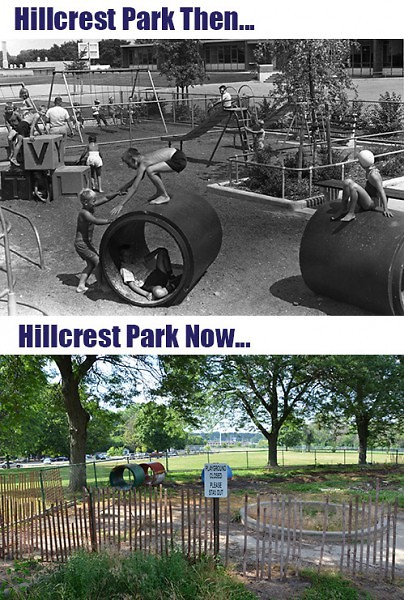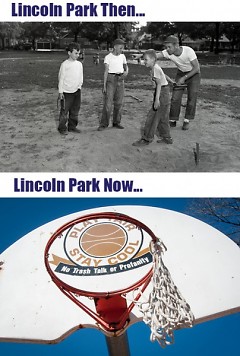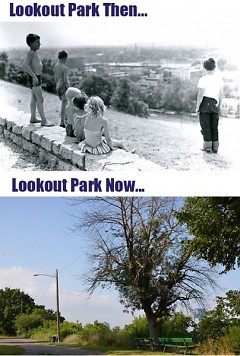The first step to solving a problem is admitting you have one. That is what Grand Rapids must currently do in order for the city to continue to grow to its full potential.
Presently the City of Grand Rapids owns and operates 73 parks and public spaces with a total of 1,210 acres of parkland. The city also owns and manages 378 acres of parkland located outside city boundaries. Grand Rapids Public Schools owns and operates a further 350 acres which is comprised of the 48 school parks. The 2011 Comprehensive Audit Analysis for Parks and Recreation paints a depressing picture of the current parks system in GR. Since 2002 the city’s Parks and Recreation Department has experienced severe cuts. Budgets for park maintenance have shrunk over 40%. The audit focused on decrease in staffing levels between 2002 and 2011 and found that in a span of nine years, staffing levels had fallen by 68%. The department currently has a limited managerial and supervisory staff with a majority of maintenance functions being conducted by seasonal employees.
Despite the small staff and major lack of funding the department has been able to maintain C level service. The report indicates that most park and recreation departments in this condition would be expected to provide a lower level of service. However C is a very meek level of maintenance that would be associated with green space locations in areas of low development and traffic. Not in the middle of a medium-sized midwest city.
The issue is not about staffing but about not investing the appropriate amount of funds into our system.
So how far behind the curve is our city when it comes to appropriate fund allocation, quantity and quality? A study from National Recreation and Park Associations (NRPA) showed that the national average is $49 in taxes for parks per resident. Grand Rapids has always been behind the national average. In 2002 the tax spending per resident was $38 which then fell to $19.34. In 2011 park maintenance expenses were $3,793 per acre for 585 acres which is the amount that is maintained. The breakdown was $11.22 per citizen. However, this was far below the approximately $6,000 per acre spent by park and recreation departments in similar cities in the midwest. Most Midwest cities have an average of 12-15 acres per 1,000 residents while Grand Rapids only has 7.88 acres.
Recreational programs, playgrounds and swimming pools are important for the growth of our children in the city. This is especially true for families living in low income neighborhoods around the city. The “2012 Parks and Recreational Operational Audit and Business Plan Development” final report showed that participation in recreational programs is increasing and is projected to reach 7,500 participates by this year but is unable to meet higher demand at current funding and staffing levels. We invest $15.60 annually per resident towards recreational programs which is low considering that similar midwest cities give $21 per resident.
“The recreation programs, especially for children, offer opportunities and experiences that may be difficult or impossible for their families to access or afford. We know that having access to recreation programs improves the school performance of children," says Chris Reader, Chair of the Grand Rapids Parks and Recreation Advisory Board. "These are the exact things we should be doing to support the children of our city, and they are what we cannot afford to do without more resources.”
We are falling short as well on swimming pools. National guidelines dictate that we should have nine pools operating during the summer to keep up with our population levels. Instead, Grand Rapids has six swimming pool facilities located in its parks. However since 2010 only three of them have been operational which has limited accessibility to residents. Instead of opening more pools, the city is shifting its focus to the development of more splash pads. They are cheaper to build and have lower maintenance costs.
Playgrounds are another important part of the community. Children need safe places to play and stay active. Grand Rapids currently has 32 but compared to the national average, it should have 57. The current projections show that if something is not done soon many of our parks will fall into major disrepair.
The data presented above is disheartening but the good news is that there is a “parks, pools and playgrounds” property millage. The millage would be for .98 mills and would last seven years. It would be included in tax bills from July 1, 2014 through June 30, 2020. It would generate $4,000,000 annually for our park system. This money can only be used for the specific purpose of improving parks.
At first glimpse this number can seem high but for an $89,000 home with an average taxable value of $44,592, or half its market value, the total tax would be $44 annually or $308 over seven years. This comes down to $3.66 per month. If the majority of citizens were to quantify the amount of park resources they utilize monthly, I am sure they would agree it is over $4 worth.
If we were to consider the 2005 study from the “Illinois Association of Park Districts” that found that housing values of homes located within 1,000 feet of a thriving community park rise by an average of 9%, A home with a market value of 89,184 within 1,000 feet of a park could have a market value reduction of $8,026 if that park did not exist. It appears from the proven economic benefits of urban green space that an investment of $308 will see a high return on overall property values in the city. Even houses located further away from parks will see positive growth of their home values if they are willing to invest in the growth of their city.
A question many people might be wondering why we are going for another tax increase in the city. Many residents want to know that all other options were studied before a millage was placed on the ballot. Going door to door for campaigns over the years it is very easy to see that a large percentage of residents in the city disagree with millages because they do not like their property taxes increased. This is understandable because no one likes paying more for anything. However, many of these residents fail to see that we are all connected in this city.
Even if a resident chooses not to utilize services such as the library, public transit or parks, they must understand that their property values are dependent on the neighborhoods they live in. A community that is not meeting service demands is not operating at its full potential and therefore its neighborhood housing values are not at their full potential. The city is currently cutting all operations by at least 20% with the parks taking the largest hit out of any department. The city can no longer rely on the General Operating Fund, which is the source of funding for the majority of municipal services, to maintain our parks. The 2011 audit featured a plethora of funding sources for parks. They included ideas such as park impact fees, internal park improvement fund, and transient occupancy tax. However, the first suggestion on the list is a millage. This is because this strategy has the potential of providing the adequate amount of funding and that over the past 10 years over 90% of park and recreation bond issues have passed across the U.S.
"The key to a more sustainable park system is to diversify revenue streams. In the past, our park system has primarily been funded through the General Operating Fund, grants, and fees. In the past few years, new funding tools have been added by the City and groups like Friends of Grand Rapids Parks to generate revenue or reduce costs, like the Special Assessment District for Pleasant Park, sponsorship opportunities for park amenities, lease agreements, volunteerism and the start of a maintenance endowment," says Steve Faber, Executive Director of the Friends of Grand Rapids Parks. "But none of these come close to the impact that dedicated parks funding has on the quality and equitable development of our park system. It's dependable revenue that enables the City and community to more deliberately plan and implement maintenance and capital projects that haven't been properly funded for nearly a decade."
The Rapidian, a program of the 501(c)3 nonprofit Community Media Center, relies on the community’s support to help cover the cost of training reporters and publishing content.
We need your help.
If each of our readers and content creators who values this community platform help support its creation and maintenance, The Rapidian can continue to educate and facilitate a conversation around issues for years to come.
Please support The Rapidian and make a contribution today.


